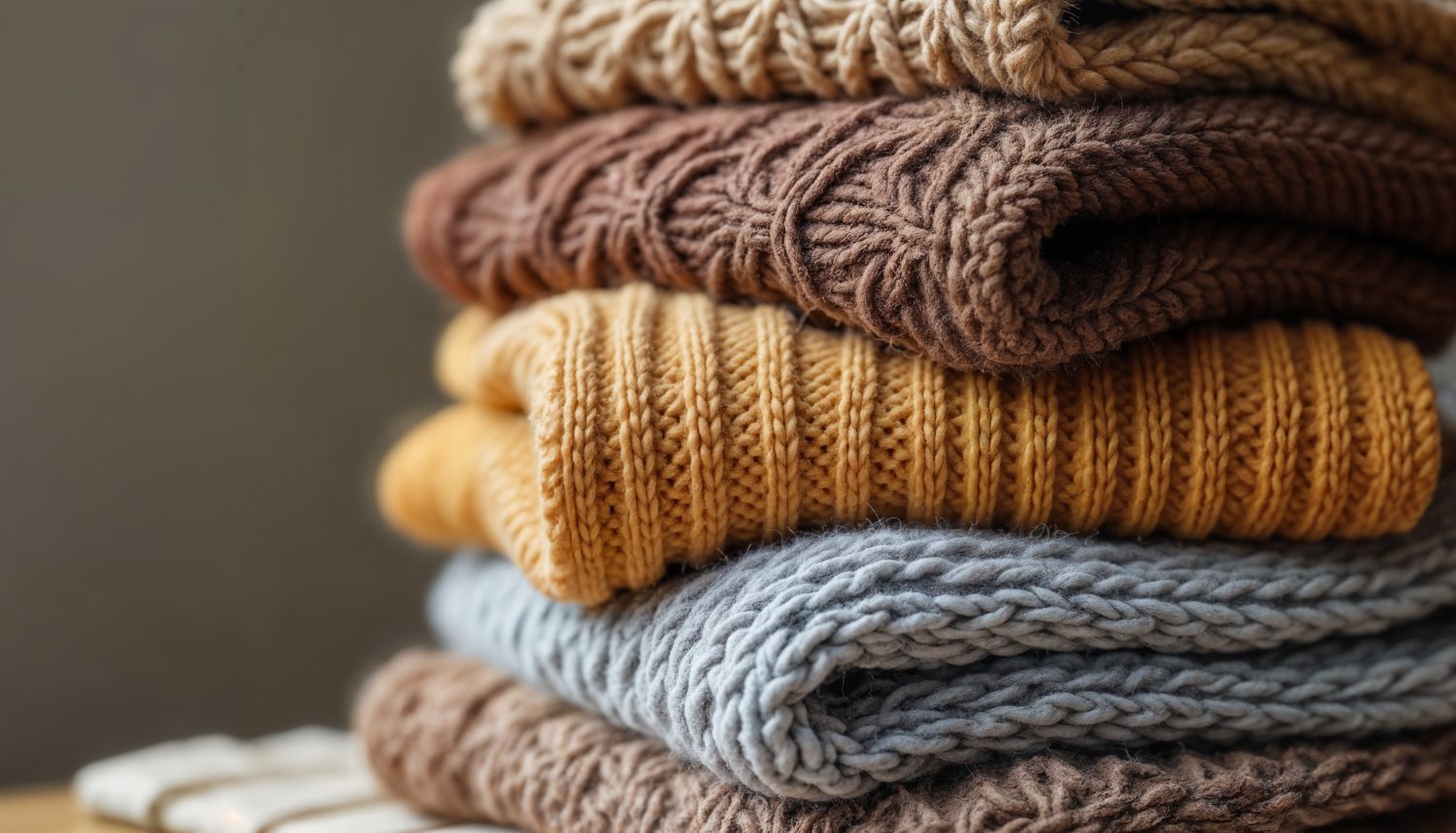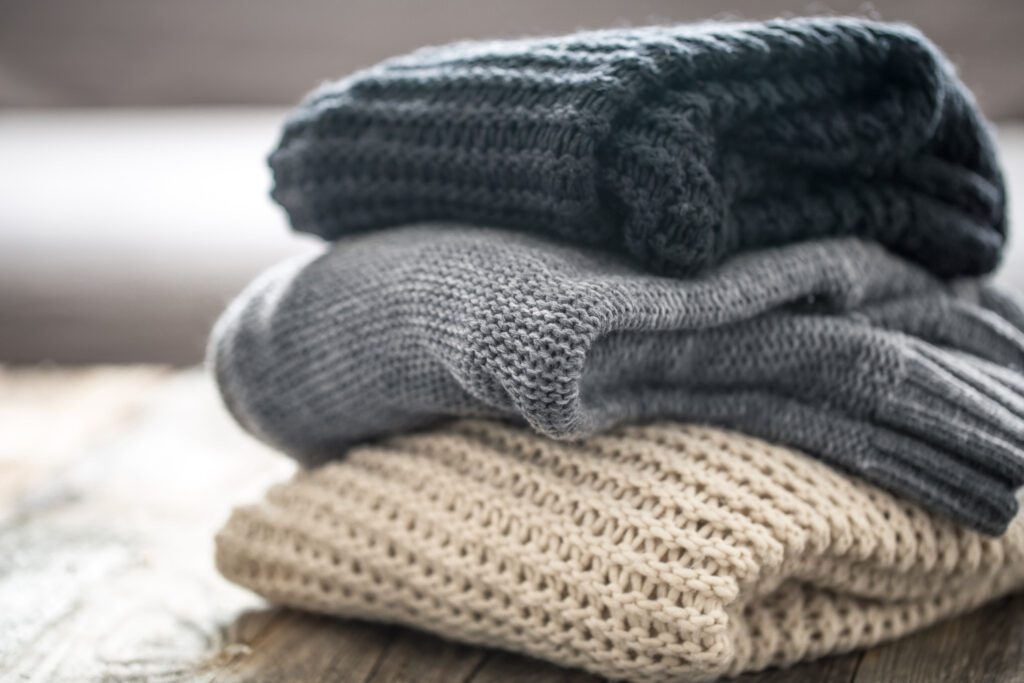 We all have those items in our closet we instinctively know to hand wash — delicate blouses, lace lingerie, maybe a vintage tee we’ve had forever. And then there’s knitwear. Soft, cozy, and usually a bit high maintenance, knits are the pieces we love to live in but dread washing.
We all have those items in our closet we instinctively know to hand wash — delicate blouses, lace lingerie, maybe a vintage tee we’ve had forever. And then there’s knitwear. Soft, cozy, and usually a bit high maintenance, knits are the pieces we love to live in but dread washing.
If you’ve ever ruined a beloved sweater and swore you’d never let it happen again, this guide is for you. We show you how to wash and dry your favorite knits the right way, so they stay soft, snuggly, and perfectly shaped all season long.
Step 1 | Check the Care Label First
Before you even fill the sink or start sorting your laundry, stop and read the care label. Knitwear comes in many types (e.g., wool, cashmere, acrylic, alpaca), and each fiber has different needs. Some sweaters can be hand washed at home, while others may require dry cleaning. The label will tell you if a garment is safe to wash, what temperature to use, and whether to avoid tumble drying.
Pay attention to these indicators on your knitwear’s tag:
- Washing symbols: Look for icons like a hand in a tub (hand wash), a circle (dry clean only), or a tub with numbers (machine washable and temperature limits).
- Fabric content: Knowing if your item is 100% wool, a wool blend, or synthetic makes a big difference in care strategy.
- Special instructions: Some knits come with notes like “reshape while damp” or “lay flat to dry” — these are non-negotiable if you want your item to last.
Step 2 | Use Cold or Lukewarm Water Only
Heat is one of knitwear’s worst enemies. Hot water can shrink natural fibers, weaken elasticity, and make soft textures feel coarse. So when washing knits, stick to cold or lukewarm water to protect the fibers and preserve the shape and softness.
Here’s how to choose the right temperature:
- Cold water (60–80°F): Safe for all types of knitwear and great for preventing color bleed and shrinkage.
- Lukewarm water (up to 86°F): Best for wool and cashmere, offering a gentle clean without shocking the fibers.
- Avoid hot water: Even synthetic knits can stretch, warp, or fade if exposed to excessive heat.
Step 3 | Choose a Wool-safe or Delicate Detergent
Not all laundry detergents are safe for delicate knits. Standard detergents often contain enzymes, brighteners, or heavy surfactants that strip natural oils and roughen the fibers. For knitwear, especially wool or cashmere, use only a wool-safe or delicate-specific detergent.
To help you pick the best product, here’s what to look for:
- Mild, pH-neutral formula: Avoid anything too acidic or alkaline, it can harden fibers and cause color fading.
- Enzyme-free: Enzymes can damage proteins in wool and silk.
- Labels that mention wool, cashmere, or delicates: Brands like The Laundress Wool & Cashmere Shampoo, Eucalan, or Woolite Delicates are formulated for gentle care.
Using the right detergent helps maintain the softness of your knitwear while removing dirt without harsh friction or chemical damage.
Step 4 | Turn Inside Out Before Washing
Before you submerge your sweater or load the washing machine, flip your knitwear inside out. This simple step minimizes wear and tear during the wash cycle and helps preserve surface texture and color. It also helps protect embroidered or printed designs.
Here are a few key reasons to always turn your knits inside out:
- Prevents pilling: Friction on the outer fibers can create those annoying little fabric balls.
- Preserves appearance: Inside-out washing helps protect the finish of the outer surface.
- Protects detailing: Any stitching, beading, or patterns will be less exposed to agitation.
Step 5 | Wash by Hand or Use a Mesh Bag in the Machine
Hand washing is the gold standard for cleaning knitwear. But if you’re short on time or dealing with a bulkier item, machine washing can work, as long as you do it right. A mesh laundry bag adds a protective layer, reducing the agitation and stretch risk.
Here’s how to approach both methods with care:
- Hand wash: Fill a clean sink or basin with cold/lukewarm water and detergent. Submerge the knit, gently agitate with your hands, and soak for about 10 minutes.
- Machine wash (last resort): Place the item into a mesh bag and use the gentle or wool cycle with cold water and low spin speed.
- Avoid overloading: Wash one or two knit items at a time to avoid crowding and friction.
Step 6 | Never Wring or Twist Wet Knitwear
After washing, it’s tempting to twist your garment to get rid of excess water, but resist that urge. Wet knitwear is at its most vulnerable and can stretch permanently when wrung. Instead, press out the water gently.
Here’s how to do it without damaging your sweater:
- Roll it in a towel: Lay the item flat on a clean, dry towel, roll it up like a burrito, and press down to absorb moisture.
- Gently press, don’t squeeze: Pat or press out water with your hands while supporting the garment from underneath.
- Avoid dripping: Letting knitwear hang while wet can drag down the fabric and distort its shape.
Step 7 | Lay Flat on a Towel or Mesh Rack to Dry
Once you remove excess water, lay your knitwear flat to dry. Hanging is not an option here; gravity stretches wet fibers and leaves shoulders sagging. A clean towel or mesh drying rack gives your garment support while allowing air to circulate.
Here’s how to get it right:
- Use a fresh, dry towel or breathable mesh rack.
- Reshape the garment: While it's still damp, gently stretch it back to its original measurements and align the sleeves, hem, and collar.
- Flip midway: If using a towel, flip the sweater after several hours to ensure even drying and avoid mildew.
Step 8 | Keep Away from Direct Heat and Sunlight
Drying your knitwear near a heater or in direct sun may speed things up, but it comes at a cost. Heat and UV rays can fade colors, stiffen fibers, and cause shrinkage, especially in natural materials like wool and alpaca.
For safe, effective drying, follow these tips:
- Choose a well-ventilated space: Dry indoors or in the shade with good airflow.
- Keep away from radiators or vents: Avoid placing garments near baseboard heaters or window sills with strong sunlight.
- Avoid heated drying racks: Stick to room temperature drying surfaces.
Step 9 | Store Folded (Never on Hangers)
The final step in keeping your knitwear soft and snuggly is proper storage. Hanging may be fine for jackets, but knits stretch under their own weight, especially at the shoulders. Folding is the way to go to maintain shape and avoid warping.
Here are the best ways to store knits so they last longer:
- Fold and stack gently: Don’t overcrowd shelves; let pieces breathe.
- Use breathable containers: Cotton bins or cloth storage bags work better than plastic.
- Add natural moth repellents: Cedar blocks or lavender sachets can protect against pests.
Your Sweaters Are in Good Hands — Schedule a Professional Cleaning With Arrowhead Cleaners & Laundry Today!

Knitwear behaves nothing like your everyday tees and jeans. Its yarns relax when wet, fibers tangle under heat, and delicate weaves pill if spun the wrong way. Which means one careless wash or stain treatment can mean disaster for that favorite cashmere or hand-knit sweater.
At Arrowhead Cleaners & Laundry, we offer expert dry cleaning for everything from everyday sweaters to delicate pieces (e.g., wedding dresses, leather jackets, etc.), always handled with care to avoid shrinkage or fabric damage. As a family-owned and operated business, we’ve built our legacy on precision, care, and customer satisfaction.
For added convenience, you can also opt for our Pickup and Delivery Service. We’ll come right to your door in Bismarck or nearby areas like Lincoln, Southport, and Highland Acres. Trust your knitwear to the professionals. Schedule your dry cleaning or laundry service with Arrowhead Cleaners & Laundry!

As much as we’d like our sweater to keep its snug, flattering fit, sometimes it stretches out and loses its shape. Maybe it got stretched out after too many spins in the dryer, or maybe it’s just the result of regular wear and tear. Either way, it’s frustrating when your favorite piece starts sagging at the neckline, hanging awkwardly at the hem, or losing its original shape entirely.
And it’s not just sweaters—this can happen to tees, jeans, dresses, and pretty much anything that’s been worn and washed more than a few times. But there are ways to reverse the damage, or at least improve the look and feel of the piece. This guide shares nine easy, effective tricks to help fix stretched clothing, whether it’s a sagging sweater or stretched skinny jeans. Let’s walk through your options!
1) Shrink It Back in the Wash (Gently)
If your cotton shirt or casual blouse feels too big, you can often shrink it a little in the wash without turning it into doll clothes.
How to do it:
- Wash the item in warm water, not hot. Hot water can be too aggressive and shrink it too much.
- Throw it into the dryer on low heat for 5 to 10 minutes.
- Keep checking it every few minutes, then air dry it flat once it looks better.
This works best for cotton and some poly-blends. Avoid trying this on silk, wool, or anything labeled “dry clean only”. For those pieces, you need to visit the nearest dry cleaner or find a cleaner who expertly handles delicate garments.
2) Rewash and Reshape by Hand
If you have a stretched-out sweater or knit dress, hand washing can do wonders, especially when you reshape it while it’s still damp.
How to do it:
- Fill a basin with lukewarm water and a small amount of baby shampoo or mild detergent.
- Soak your item for about 10 to 15 minutes.
- Gently squeeze out extra water—don’t wring or twist it.
- Lay it flat on a clean towel, then press and shape it by hand—fix the sleeves, neckline, and hem while it's damp.
Let it air dry flat—never hang it. This trick is especially good for wool sweaters and blouses, which can stretch just from being on a hanger too long. It’s the kind of tip even a seasoned dry cleaner would recommend for in-between cleanings.
3) Use Steam to Tighten Fabric
Steam helps relax and reshape fabric fibers that have stretched out. This method is especially great for shirts, skirts, or dresses made of cotton or linen.
How to do it:
- Use a handheld steamer or hang the garment in the bathroom during a hot shower.
- As the fabric warms up, use your hands to smooth and reshape it.
- Let the item dry naturally while hanging.
This method is safe for most everyday clothes, but skip it for silk or leather, as those fabrics need more specialized care. If you’re not sure, it’s a good idea to drop it off at the closest dry cleaner that handles specialty garments.
4) Tailor It Back Into Shape
Sometimes, a piece is too far gone for a quick fix, and that’s where you should let a professional tailor handle it. If the item has sentimental value or fits you well in most spots, it’s worth adjusting professionally.
Tailors can:
- Take in the waist or sides
- Shorten stretched-out sleeves
- Add darts or new seams for better structure
Tailoring is especially helpful for structured items like jackets, wool coats, or formal dresses. Many reputable dry cleaners have tailors in-house or can refer you to one. It's more affordable than replacing a high-quality item, and the customer service is usually topnotch.
5) Add Elastic for a Quick DIY Fix
If your waistband or sleeve cuffs have lost their stretch, a small piece of elastic can fix the problem without needing a full alteration.
How to do it:
- Cut a strip of elastic the length you want the band to be.
- Sew it into the inside seam of the waistband or cuff using a zigzag stitch (or hand-sew if needed).
- Stretch the fabric as you sew so it pulls in nicely.
It might sound advanced, but this is a simple DIY that’s beginner friendly. If you’re nervous about it, check if your nearest dry cleaner also offers small repairs. They often do jobs like this at a reasonable price.
6) Spray and Reshape (for Cotton and Jersey)
This is a great option when your shirt or T-shirt has stretched just a little around the collar or hem. This works well for jersey knits and cotton tees—the kind you don’t want to toss but aren’t sure how to fix. It’s fast, easy, and doesn’t require any sewing or special tools.
How to do it:
- Fill a spray bottle with lukewarm water.
- Lightly spray the stretched area.
- While damp, use your hands to pull or push the fabric back into shape.
- Lay the garment flat and let it air dry.
7) Freeze Your Denim (Yes, Really)
Jeans can stretch a lot with wear, especially around the knees or waistband. Freezing can help them feel tighter again while also killing odor-causing bacteria. It won’t shrink them dramatically, but it firms up the fibers and can give you a snugger fit. It's also an environmentally friendly trick that keeps you from overwashing your denim, which helps preserve the fabric longer.
How to do it:
- Fold your jeans and place them into a zip-top plastic bag.
- Leave them in the freezer overnight.
- Let them thaw out naturally before wearing.
8) Use Fabric Spray Starch for Support
Have a shirt or blouse that’s gotten a bit floppy? Fabric spray starch is a quick fix that can restore some crispness and structure—perfect for shirts, collars, or cotton dresses. This gives the fabric that fresh-from-the-cleaners feel. Just don’t overdo it, as too much starch can build up and attract dirt.
How to do it:
- Lay your item on an ironing board or flat surface.
- Spray lightly with fabric starch—don’t soak it.
- Iron the fabric until it’s dry and crisp again.
9) For Knits and Sweaters: Try a Cold Water Soak + Reshape

If you’ve ever pulled a sweater out of storage and found it saggy or stretched, this one’s for you. This method works especially well for wool and cashmere, and it’s a great way to freshen up sweaters without a full wash.
How to do it:
- Soak the sweater in cold water (no detergent needed unless it smells).
- Gently press out excess water with a towel—again, don’t wring.
- Lay it flat on a towel and reshape it with your hands, gently guiding it back into its original form.
Let it air dry flat, and avoid using hangers. If the knit still looks tired, take it to a dry cleaners that handles wool and sweater care specifically.
Keep Your Clothes in Shape with Professional Care from Arrowhead Cleaners & Laundry!
If you're confident enough to try saving your stretched-out clothes at home, great—but if you'd rather skip the hassle and get it done right, trust the experts at Arrowhead Cleaners & Laundry. We offer professional dry cleaning solutions for everything from delicate fabrics and stretched sweaters to specialty garments like leather, suede, and fire-resistant clothing.
But we don't stop at these pieces. We even clean and preserve wedding dresses and deep clean household items. We use environmentally friendly products and advanced cleaning techniques to treat various kinds of stains and ensure the best cleaning results for every item.
We are located at 1140 North 3rd Street, Bismarck, North Dakota, but we also service the surrounding areas. Contact us today at 701-223-3311 for all your inquiries!

